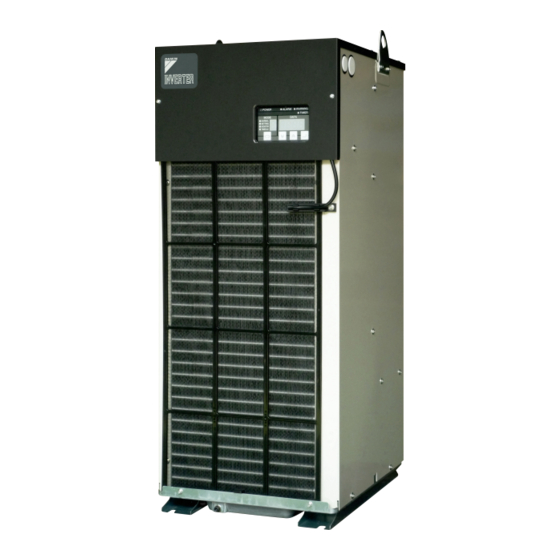
Table of Contents
Advertisement
PIM00318A_EN.fm Page -1 Tuesday, October 26, 2010 12:37 PM
DAIKIN Oil Cooling Unit
("OILCON")
AKZ9 Series
Models
Menu
Built-in
Standard
breaker
model
model (-B)
Series
AKZ149
AKZ329
AKZ439
Thank you for purchasing DAIKIN Oil Cooling Unit ("OILCON").
This instruction manual includes instructions for using the Oil
Cooling Unit.
To ensure proper use of this product, be sure to read through this
instruction manual before using it.
After reading this manual, keep it handy for your future reference.
Proper use results in power saving
If the air filter is clogged, the cooling performance deteriorates,
causing excess power consumption.
Clean the air filter periodically to reduce power consumption.
Instruction Manual
Circulating type
Compliant with
ROHS
Built-in heater
Built-in tank
model
model
Built-in breaker
model
CE model
Built-in
CE model
Different-
heater
(-C)
voltage
model (-H)
Installation
Handling
Different-voltage
model
Built-in
tank model
(-T)
Maintenance
although no alarm is activated
• When a warning is generated
CE compliance declaration
PIM00318A
CONTENTS
1
4
5
6
7
8
13
14
15
16
18
19
20
21
22
23
24
25
27
30
33
33
34
35
36
37
38
42
Advertisement
Table of Contents

Summarization of Contents
Safety Precautions
Installation Safety Precautions
Guidelines for safe installation, electrical wiring, and securing the unit.
Installation
Unit and Accessories Check
Verify the Oil Cooling Unit and its included accessories before installation.
Transportation and Storage Procedures
Safe methods for transporting, conveying, and storing the unit.
Installation Site and Piping Requirements
Conditions for installation location and essential oil piping specifications.
Pipe Selection Reference
Guidance on selecting appropriate pipe sizes and lengths for oil connections.
Electric Wiring Guidelines
Instructions for connecting the power supply and controlling the Oil Cooling Unit.
Circuit Breaker Mounting
Procedure for installing a circuit breaker specifically for the Oil Cooling Unit.
Wiring Procedure Steps
Step-by-step instructions for performing the electrical wiring of the unit.
Electrical Equipment Box Layout
Diagram and explanation of internal electrical components and wiring.
Remote Control Input Connection
How to connect a remote control switch for unit operation.
External Output Contact Connection
Connecting external output contacts for operation status signals.
Handling
Part Identification and Functions
Identification and functional description of the unit's main components.
Control Panel Parts Overview
Explanation of control panel buttons, indicators, and display elements.
Operation Modes Explained
Description of the seven available operation modes for the control panel.
Checking Initial Operating Conditions
Procedure for verifying initial operating conditions and settings after setup.
Operating Procedure
Operation Setting Modes
Overview of various modes for setting oil temperature and capacity.
Holding Constant Oil Temperature
How to configure the unit to maintain a constant oil temperature.
Temperature Tuning to Room/Machine Temp
Setting oil temperature control relative to room or machine temperature.
Constant Capacity Cooling Operation
Setting the unit to operate at a specified cooling capacity percentage.
Useful Functions
Monitor Items List
List of parameters and values that can be monitored on the unit.
Timer Operation Function
How to use the ON timer to start the unit after a specified delay.
Additional Setting Functions Overview
Introduction to additional functions like auto-tuning and temperature range warnings.
Parameter List for Settings
A comprehensive list of parameters for configuring additional functions.
Parameter Setting Procedure
Step-by-step instructions for setting various operational parameters.
Temperature Range Warning Setup
Configuration of warnings for oil temperature exceeding a specified operational range.
Parameter Settings Description (Group A)
Details on setting parameters for temperature range warnings (Group A).
Parameter Settings Description (Group B)
Details on setting parameters for temperature range warnings (Group B).
Auto-tuning for Temperature Control Improvement
Using the auto-tuning mode to enhance temperature control performance.
Auto-Tuning Operation Flow
Visual guide illustrating the step-by-step process of auto-tuning.
Auto-Tuning Operation Details
In-depth explanation of the steps involved in the auto-tuning process.
Optional Parts
Alarm/Warning Output Logic Configuration
Setting how alarm and warning signals are transmitted to the main machine.
Optional Protection Device Alarm Settings
Configuring alarms for optional protection devices connected to the unit.
Machine Temperature Tuning Control
Utilizing optional thermistors to adjust control based on machine temperature.
Optional Part Mounting Procedure
Instructions for correctly installing optional parts onto the unit.
Returned Oil Temperature Control
Performing control by detecting returned oil temperature using optional components.
Main Machine Communication Setup
Connecting the unit to the main machine via an optional board for data exchange.
Maintenance
Daily Maintenance and Inspection
Routine checks and cleaning for daily upkeep and optimal unit performance.
Periodic Maintenance and Inspection
Scheduled maintenance tasks, including cleaning and component checks.
Suction Strainer Maintenance
Procedure for cleaning the suction strainer to prevent dust clogging and cavitation.
Air Filter Maintenance
Instructions for cleaning or replacing the air filter for optimal cooling and efficiency.
Condenser Maintenance
Checking and cleaning the condenser for efficient heat exchange.
Exterior Cleaning
Guidelines for cleaning the exterior casing of the unit.
Evaporator Inspection
Checking the oil level and piping for the evaporator.
Heater Inspection
Performing periodic inspection of the heater for dust clogging.
Oil Drain Maintenance
Procedure for inspecting and discharging accumulated oil from the drain port.
Electric Component Box Packing
Action required if the electric component box packing is damaged.
Long-Term Unused Unit Preparation
Precautions for storing the unit when it will be unused for an extended period.
Troubleshooting
Abnormal Operation Without Alarm
Troubleshooting steps for issues occurring without active alarm indicators.
Troubleshooting Activated Alarms
A list of alarms, their potential causes, and corresponding corrective actions.
Troubleshooting Activated Warnings
A list of warnings, their potential causes, and corresponding corrective actions.
CE Compliance Declaration
EC Declaration of Incorporation
Declaration of conformity for CE models regarding machinery directives and standards.
















Need help?
Do you have a question about the AKZ149 and is the answer not in the manual?
Questions and answers